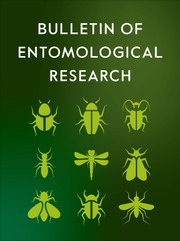No CrossRef data available.
Article contents
Functional role of TaGSTs1 in the detoxification of spinetoram and development of Tuta absoluta
Published online by Cambridge University Press: 25 August 2025
Abstract

Tuta absoluta has evolved resistance to many biological insecticides, resulting in significant annual agricultural and economic losses. Glutathione S-transferases (GSTs) are one of the major insect detoxification enzyme systems. However, the detoxification metabolism of GSTs in T. absoluta against biological insecticides remains poorly understood. In this study, We identified five key GST genes (TaGSTs1, TaGSTs2, TaGSTe1, TaGSTe3, and TaGSTd1) by screening from the comparative transcriptomes of two regional populations of T. absoluta in Xinjiang, China. Among the five GSTs, TaGSTs1 exhibited a significantly high expression level during the larval stage of T. absoluta following exposure to the LC50 dose of spinetoram. This gene was subsequently cloned, and its expression was knocked down using RNA interference to further analyse its role in the detoxification of spinetoram, as well as in the growth and development of T. absoluta. The results showed that TaGSTs1 contains a typical GST gene domain and was highly conserved within the Lepidoptera clade. Silencing of the TaGSTs1 gene led to a significant increase in the susceptibility of T. absoluta to spinetoram, as evidenced by an extension in the duration of leaf-mining and in the development time from the 2nd to the 4th instar larval stage, which were 35.7% and 19.6% longer, respectively, than those of ddH2O and dsGFP controls. Furthermore, the mortality rate of larvae treated with dsTaGSTs1 reached 57.3% by the 7th day. These findings indicate that TaGSTs1 plays a crucial role in the detoxification of spinetoram and in the growth and development of T. absoluta larvae.
Information
- Type
- Research Paper
- Information
- Copyright
- © The Author(s), 2025. Published by Cambridge University Press.
Footnotes
Co-first authors.


